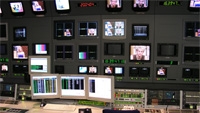Automating DVE effects

Digital effects have been with us for some time, providing transitions between program material and the insertion of logos. Now that the technology has improved to the point where they can be used on-air cost effectively, more sophisticated effects can be created combining multiple program streams, animations and textual information.
It is worth remembering that it is not necessary to render effects in real-time. Material can be prepared in advance with prerendered effects ready to be transmitted later. Of course, the latest effects devices can also be used in this way; however, it is better to control the effects in real-time in the transmission path because it allows the broadcaster instant control.
Prepared effects are typically worked on hours ahead of the transmission time, or even the previous day. The work will need to be amended if any changes are required and material can't be changed with only a few minutes to go until the on-air time, but sometimes the benefits outweigh these risks.
Motor sports
One example is the Formula 1 motor race. Any sporting event that would have commercials inserted during the event, rather than during a break in the sporting action, would have the same problem. To run the next commercial break, you want to shrink the race into a small window, bring another window to the front and run the commercial break in it (this is legal in some countries). Those viewers who would normally change channels during the commercial break will now stay tuned, because they can still see the race in the small window.
But what happens if something interesting happens in the race? You want to go back to the race after the end of the current commercial, rather than waiting for the end of the break. So, you need the reverse DVE to come back to full-screen. This is not possible if the break and effects are prepared in advance — you need the DVE in the transmission path.
This brings us to automation. To be able to react quickly and flexibly is the hallmark of a good automation system, and this is where the challenge is for automation companies. In the F1 example, the operator doesn't have time to remember which effect was used at the start of the break, and he or she doesn't have time to set up the DVE manually to run exactly at the end of the commercial. The operator wants to be able to push a button and let the automation system take control.
The professional video industry's #1 source for news, trends and product and tech information. Sign up below.
In this example, the automation system must select the correct effect, it must delay the remaining clips of the break so they can be taken later and it must freeze the commercial on the last frame of video and run the DVE frame accurately. With the last frame of the commercial frozen during the squeeze-back, the motor race can go back to full screen. When this is completed, clips that were left over from the end of the break need to be prepared, preceding them with the correct start-of-break material and adding the correct start DVE, ready for the operator to take them as the next commercial break. A significant amount of machine "intelligence" is needed for such an apparently simple requirement.
In general, the automation system needs to control the keying layers and the assignment of secondary events to the main event (anything up to 16 layers and events), while also being able to adjust the duration of each secondary event to achieve the desired and immediate result.
The more intelligence you build into the automation system, the easier it becomes for the operator. This is part of the challenge for the automation system provider — how do you make the system intelligent, but still allow the operators the flexibility they need to be able to cope with the unexpected?
Reliability of live effects
Perhaps the biggest issue, when we look at how DVEs can be used to enhance on-air transmission, is reliability. It’s not just the hardware that should be reliable, but also the controlling software guaranteeing that the on-air effect is exactly what the broadcaster intended.
If we look again at the original method in which DVEs are prepared in advance onto a tape or to a video server, we can see the point clearly. If the effect does not start at exactly the correct frame in the video, the operator can rewind the tape and try again until it is correct. When DVEs are programmed to run on-air, however, there is no second chance — it has to be correct every time. If the system gets it wrong, perhaps by just one frame, then there’s a chance of black screen or a flash-frame at the start or end of the transition, ruining the effect.
Frame accuracy is the issue here. To achieve it is more difficult than many automation suppliers admit, perhaps because for simple automation requirements it is not a critical problem. For a computer to send a list of clips to a video server and tell it to play them is easy — in this case the video server handles the transitions between the clips and it is itself frame accurate. Many automation suppliers will claim that their automation system is frame accurate, and so it is, unless you also want to start programming DVEs or other on-air elements that have to be controlled separately.
That's the other part of the challenge for automation suppliers: to achieve true frame accuracy so the broadcaster can use all of the different elements that you want to see on-air — mixer transitions, logos, DVEs, captions and anything else that's available today and in the future.
Richard Thomas is software development director of automation specialist Abit
For more information, visit www.abit.co.uk.
